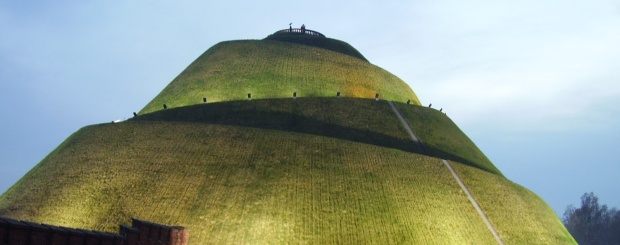Mounds of Krakow
There are four mounds in Krakow today. Let us begin with the oldest, and the legends that are set around it. The Mound of the Krakus is located in the Podgorze district. It is 16 metres high and it was most likely heaped up in the 7th century – as seems to be indicated by the bronze Avar jewel found in its interiors in the 1930s, during an archaeological excavation. The mound is considered a grave of the legendary founder of city, Krakus. A huge oak used to grow on to p of the mound, and in the 16th century, the Lord’s Passion stood on top in the form of a cross .
Wanda’s Mound stands on guard of the north borders of Krakow. It separates the housing area of Nowa Huta from the Lenin Metallurgic Plant (present day Tadeusz Sendzimir Plant). It is only 14 metres high, but it is also very old. The legendary name of this site is Wanda’s Tomb. Wanda was a ruling princess who rather than marry a German prince, threw herself into the currents of the Vistula river. This event also led to the naming of the village – Mogila, meaning Tomb in Polish. It is the village that became a site for the buidling of Nowa Huta (The New Mill), Krakow’s industrial district.
It is assumed that both of these mounds where sites which served the purposes of guarding and signaling. In older times, the peak of Wanda’s Mound was adorned with a stone statue which represented the heroine, with an engraving into the scaffolding that praised her actions. Unfortunately, the statue and the engraving gradually eroded. At present, a marble eagle designed by Jan Matejko crowns the mound.
The third and the biggest of these is the 34-metre Tadeusz Kosciuszko Mound, located on the hill of St. Bronislawa. It was raised over a period of three years, from 1820 till 1823. It is made with soil from the battlefield of Raclawice, Maciejowice and Dubienka, as well as American soil – all collected from places where Kosciuszko once fought. The soil from Maciejowice – a battleground which saw Kosciuszko fall from his horse, heavily wounded – was transported in Vistula ship a by Countess Izabela Czartoryska. Between 1844-47 a road was built from Zwierzyniec to the top of the mound, and in 1862, the mound was crowned with a Tatra granite stone engraved with the dedication ‘To Kosciuszko’. In 1856, the Austrians surrounded the mound with fortifications.
The youngest mound in Krakow is the Jozef Pilsudski Mound, located in the Wolski Forrest. Its construction began in 1934, while the Marshall was still alive, and completed in 1939. In 1981, the Pilsudski Mound was included on the list of Krakow’s historic heritage sites.
There was once another, fifth mound in Krakow, in the Lobzowo area. People would say that it was the tomb of Esterka (literally little Esther), the Jewish beloved of king Casimir the Great. Those, who remembered the king said that it was not a big mound and it simply „melted”. No trace remains of it today. Apparently, it was simply flattened out and liquidated as part of the terrain’s preparation for a soccer field.






